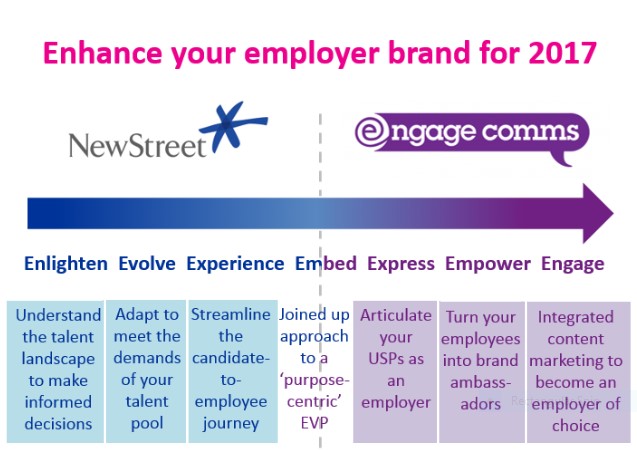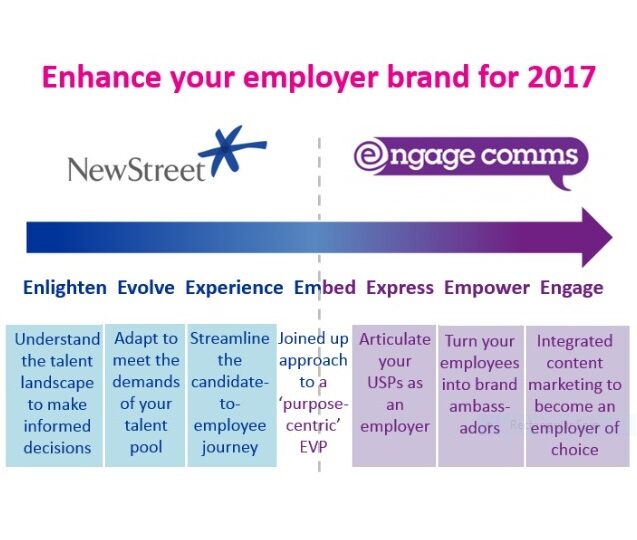Last month, New Street’s talent consulting team hosted an event in partnership with employer branding specialists Engage Comms Ltd at Ilkley Cinema, not far from our offices in Harrogate. The event entitled ‘Enhance your employer brand for 2017’ was designed to help HR and marketing professionals understand how, by working together, they can become an ‘employer of choice’ to attract, recruit and retain top talent.
The event was attended by HR and marketing directors from a variety of organisations working in a wide range of sectors including construction, financial/professional services and manufacturing. At the start of 2017, all these organisations are facing common challenges from the uncertainty of Brexit to an ever increasingly candidate-driven marketplace.
As a talent research specialist, I have seen employer branding evolve in recent years and what it clear, is that talent insight, ‘recruitment marketing’ and ongoing employee engagement can no longer be looked at in isolation. As Engage Comms’ Founding Director Helen Gill says: “In the age of transparency, internal culture and external brand are one and the same.” That’s why we are working in partnership with Engage Comms to offer clients the ability to align the whole process of talent identification, acquisition and retention for improved business performance.
The cost of getting it wrong
A key theme we explored in the session was the fact that an employer branding strategy is not a luxury – there is a clear business case for it. According to research by Glassdoor, 84% of employees would consider leaving their current company if an employer with an excellent reputation offered them a job and 69% would decline a job offer from an employer with a bad reputation – even if they were unemployed. So, company reputation can hold back talent attraction but poor recruitment practices can also waste time and money and impact overall business performance. Having the wrong people in your business can change the culture, creating a vicious circle and leaving you unable to attract the right new talent.
Virgin Media counted the cost of poor candidate experience and found they were losing millions in customer revenue, serving as a reminder to us all that candidates and employees are also customers and can either be our biggest ambassadors or our biggest critics. Since they can now tell the world about this online, treating them poorly can be incredibly costly.
The key is not to wait until things go wrong – organisations in 2017 need to be proactive and plan ahead for the future if they are to reap the benefits of a strong employer brand. You can no longer afford to set up a flashy careers site if it’s not a true reflection of who you are as an organisation. It needs to be authentic and it needs to be insight-based.
7 steps to enhancing your employer brand

New Street and Engage Comms’ 7 step approach to enhancing your employer brand in 2017 provides an integrated, strategic framework for long term success. It fuses talent research and insight with clever content marketing to maximise the impact of both.
1. Enlighten
As talent research and insight experts, we work with our clients to understand their talent landscape, build talent communities and get under the skin of what candidates are looking for. What clients then do with this insight, determines whether they succeed in developing a long term, sustainable attraction and retention strategy or whether they use it to plug an immediate gap to put bums on seats!
You will undoubtedly get the greatest return on your investment in employer branding if it is insight based. What is the current perception of your brand as an employer internally and externally? What does top talent look like for your organization in your marketplace? What is going to attract talent? Where do they look for new roles and what are your competitors doing to attract and retain them? By gaining the insight first, you can make informed decisions and avoid wasting time, effort and resource in the longer term.
2. Evolve
Adapting to meet the demands of your talent pool and creating the proposition to put you in the best position to attract and retain talent is an important next step. This covers everything from your culture and values, access, flexible working, CSR, career and development and pay and reward and the key thing to consider here is that you can’t appeal to everyone and nor should you try! Evolution shouldn’t come at the expense of core values.
Work carried out by Odeon is a strong example of this. The national cinema brand asked its own employees to define the brand’s vision and values which became their ‘pledge’ to all future and current employees – “It’s not enough to simply talk about our vision and values they should shine through in every service, experience and interaction. And what better way to achieve this than by handing over to our extraordinary and immensely creative colleagues.” (Odeon careers site)
3. Experience
Streamlining the candidate experience is fundamental to employer reputation, particularly in the social media age when everyone is a critic. The experience runs from initial contact and marketing and continues throughout the recruitment process and employee journey. Your existing employees form a key part of this experience and candidates need to be able to virtually experience what it is like to work for the organisation.
Household smoothie brand Innocent captures its candidates from the very first touchpoint and everything from the interview process to what an employee does when they leave the business is geared towards keeping them engaged with the brand as a customer over the long term. Entrepreneurship is a key value for Innocent and its ‘life after innocent’ stories demonstrate how they help and support the entrepreneurial endeavors of employees once they leave the business.
4. Embed
Once you’ve gained the insight, evolved the business and honed your candidate experience, all of this needs to be embedded within the organisation to ensure that internal culture and the external customer facing brand are aligned. HR, marketing, PR, internal comms and organisational development must work together to create an employee value proposition that is ‘purpose’ centric, rather than ‘you’ centric. Personal benefits are important but anyone can offer those, what’s the REAL differentiator? What’s the ‘end game’? Employees make up your organisation, they should create the culture and the values (not have these forced upon them!)
5. Express
This is where Engage Comms’ content marketing expertise comes in. Once you have the right culture and values embedded, you need to be able to articulate it in a way that will resonate with your talent pool. While you can engage prospective talent with more in-depth content once you have captured their attention, you need a simple, memorable proposition that sets you apart and gives you a clear point of differentiation as an employer of choice for a specific type of person.
Dyson summarises its employer brand in line with its customer brand perfectly by saying: “Dyson is different. Our culture is unique. It’s certainly not for everyone. But if you thrive on challenge and are excited by change – it could be for you.”
The key is not to try to be ‘all things to all people’ and focus more on the purpose of the organisation than the individual benefits. This will attract the right people for your business.
6. Empower
Your people are your employer brand, without them as the ‘face’/’voice’ of it, it means nothing. Engage Comms are specialists in people-focused content and found that their customer engagement campaigns were also helping their clients attract and keep top talent by showcasing their expertise. You need to empower your people to shape and embody the employer brand – not with short term incentives but by investing in them and their personal brands over the long term. This has the added benefit of making them feel more valued and therefore more productive in their roles and more loyal to the organisation. Reviews are critical (whether its customers on Trip Advisor/Trust Pilot or employees on Glassdoor) for building trust and credibility.
7. Engage
As the team at Engage Comms say: “Content marketing is a commitment, not a campaign” (Jon Buscall) and this is no different whether you are creating content aimed at customers or candidates; it needs to be an ongoing effort. Creative content that engages target audiences and stays ‘front of mind’ with them in the right place, at the right time is key to engaging top talent and is as much about listening as it is about talking. Tracking what’s on the agenda and engaging in topical conversations will help you to do this as will responding to things like feedback on Glassdoor reviews in a genuine way. Don’t be afraid to use this intelligence to make real change – it’s an opportunity not a threat!
There’s no ‘magic bullet’ for creating an effective employer branding strategy in 2017 but a joined-up approach between HR and marketing is the best starting point.



